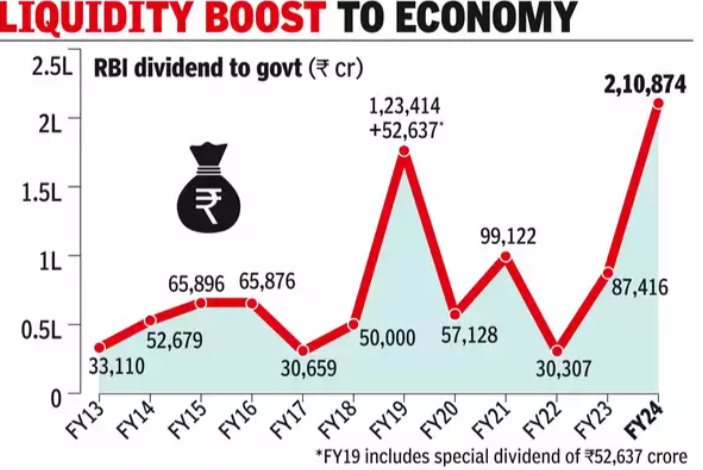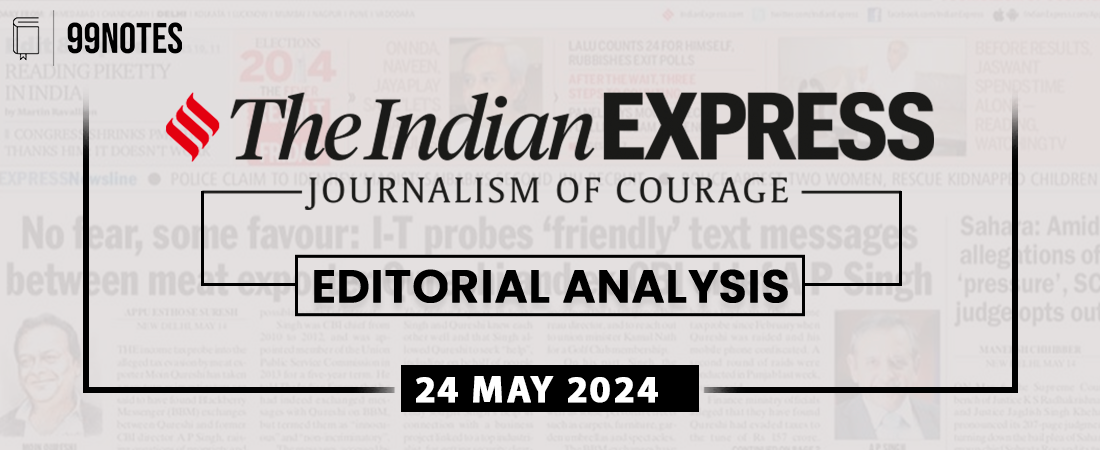24 May 2024 : Indian Express Editorial Analysis
1. Model code and context
| Topic: GS2 – Polity – Constitutional Bodies |
| Context: |
|
The Concept of Truth:
- The article delves into the philosophical inquiry of truth, invoking Francis Bacon’s essay “Of Truth.”
- It suggests that truth is complex and multifaceted. The Ashokan pillar’s emblem, with its four lions, metaphorically represents different perspectives of truth:
- one that is visible to the speaker,
- another to the listener,
- a third to an observer, and
- a fourth dimension that remains unfathomable, often referred to as known only to God.
The Model Code of Conduct (MCC):
- The ECI enforces the Model Code of Conduct (MCC) during elections, aiming to ensure candidates and political parties adhere to ethical standards.
- The article discusses the inherent challenge in expecting individuals to exhibit model behavior during campaigns if they do not practice it in their daily lives.
- The MCC’s adoption came with the hope of instilling self-restraint among political stakeholders.
- The ECI’s 2019 Manual on MCC emphasized that aspiring representatives should demonstrate exemplary behavior.
Political Discourse and Language:
- The article addresses the degradation of political discourse, where some political leaders’ coarse language reflects their intentions.
- It contrasts a “model” code with a “moral” code, explaining that morality is subjective and deeper than legal guilt.
- Citing Immanuel Kant, it differentiates between legal guilt based on actions and ethical guilt based on thoughts.
Legal and Ethical Challenges:
- The MCC prohibits activities that exacerbate communal tensions or appeal to caste or community for votes, considering such actions as corrupt practices under the Indian Penal Code and the Representation of the People Act, 1951.
- However, proving these violations requires explicit connections to election activities, creating loopholes for political actors to exploit through ambiguous language.
The Mahabharata Analogy:
- The article draws a parallel with the Mahabharata, recounting how Yudhishthira’s half-truth about Ashwathama’s death led to unintended consequences.
- This analogy illustrates the complexity of truth and its impact on morality and ethics, suggesting that electoral integrity requires both a robust MCC and a conscientious approach from all participants.
Conclusion:
- The article calls for a re-evaluation of the MCC and a collective reboot of societal conscience.
- It stresses that while elections are crucial for democracy, they should not compromise the moral foundation of society, as such damage could have long-lasting effects beyond the electoral process.
| What are the Issues Associated with MCC? |
|
| PYQ: Discuss the role of the Election Commission of India in the light of the evolution of the Model Code of Conduct. (UPSC CSE (M) GS-2 2022) |
| Practice Question: Discuss the significance of ‘Satyameva Jayate’ in the context of the Election Commission of India’s mandate. How does the Model Code of Conduct (MCC) reflect the ethical challenges of ensuring fair elections, and what measures can be taken to strengthen the integrity of the electoral process in India? (250 words/15 m) |
2. A WINDFALL GAIN
| Topic: GS3 – Indian Economy |
| Context: |
|
 Basis for Surplus and Buffer Determination:
Basis for Surplus and Buffer Determination:
- The surplus and contingency buffer have been determined based on the economic capital framework recommended by an expert committee headed by former RBI Governor Bimal Jalan.
- The unexpectedly high transfer likely results from increased interest income from the RBI’s foreign and domestic assets and forex transactions.
Implications for Fiscal Policy:
Creation of Fiscal Space
The higher than expected surplus transfer creates considerable fiscal space for the next government, equating to around 0.4% of GDP. This can be utilized in several ways:
- Reducing Fiscal Deficit: The government could bring about a steeper decline in the fiscal deficit than previously outlined. The interim budget aimed to reduce the deficit from 5.8% of GDP in 2023-24 to 5.1% in 2024-25.
- Offsetting Revenue Shortfalls: The surplus could help offset potential revenue shortfalls in areas such as disinvestment.
- Increasing Capital Expenditure: The government might increase the allocation for capital expenditure from the budgeted Rs 11.1 lakh crore (3.4% of GDP).
Impact on Markets
- The immediate impact of the surplus transfer is evident in the financial markets, with the 10-year bond yield falling.
Commitment to Fiscal Consolidation:
- In the Union budget for 2021-22, the government announced a fiscal deficit of 9.5% of GDP for 2020-21 and committed to reducing it to below 4.5% by 2025-26.
- Subsequent budgets have reaffirmed this commitment, with a steady increase in the allocation for capital expenditure.
- The center’s capex to GDP ratio has risen from 2.5% in 2021-22 to 3.23% in 2023-24, and further to 3.4% in the 2024-25 interim budget, enhancing the quality of spending.
- It is crucial for the next government to continue this path of fiscal consolidation and capital expenditure investment.
| Bimal Jalan Committee Recommendations |
Formation:
Recommendations:
Note:
|
| PYQ: Which of the following statements is/are correct regarding the Monetary Policy Committee (MPC)? (2017)
1) It decides the RBI’s benchmark interest rates. 2) It is a 12-member body including the Governor of RBI and is reconstituted every year. 3) It functions under the chairmanship of the Union Finance Minister. Select the correct answer using the code given below: (a) 1 only (b) 1 and 2 only (c) 3 only (d) 2 and 3 only Ans: a |
| Practice Question: Evaluate the implications of the Reserve Bank of India’s surplus transfer to the central government. How can the increased fiscal space be strategically utilized to balance between reducing the fiscal deficit and enhancing capital expenditure? (250 words/15 m) |





